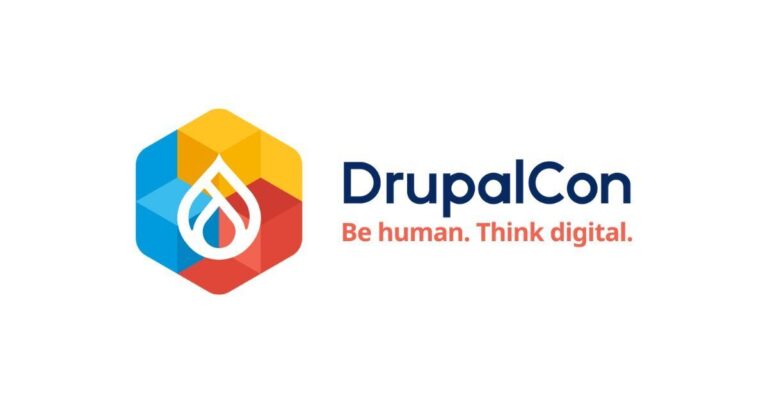As a Linux user, you might wonder why someone would ever want to replace it with Windows. Be nice! It’s always good to see how other operating systems work. And being proficient in Windows, Mac, and Linux is super useful in a professional environment. But that’s another topic.
In this now updated article, I’ll be sharing my experience of switching to Windows 10 as my daily OS. Including how I found alternatives to some Linux apps I use daily, and how I integrated WSL (Windows Subsystem for Linux) into my workflow for command line Linux access.
I’ve also included my pros and cons of using Windows 10 as my daily OS and how it compares to Linux. I’m excited to share but please note this is a work in progress.
As promised, almost 1 year later, I have updated this article.
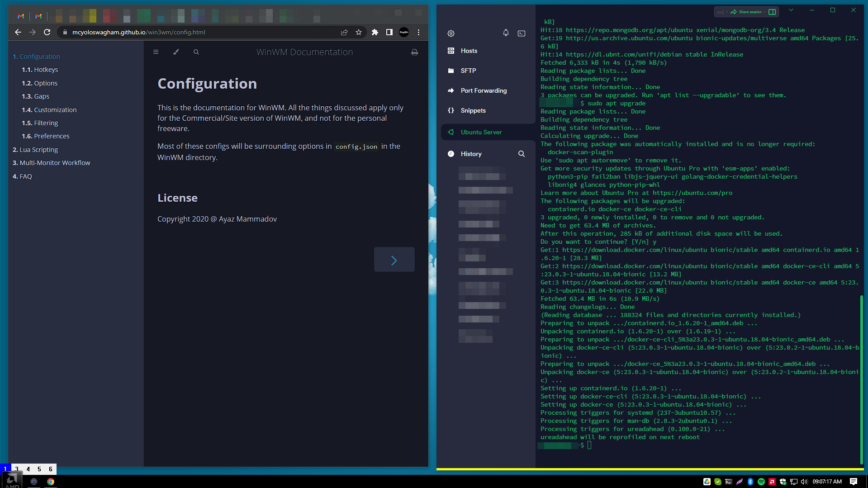
Windows 10 + Win3WM tiling Window manager with workspaces open.
Table of Contents
My Windows-to-Linux Journey
I’ve been a Linux user for over a decade before I switched back to Windows. But my computer and operating system history goes back much further. I had the chance to play with Commodore 64, Amiga 500, Apple Macintosh and Atari 2600 when I was young.
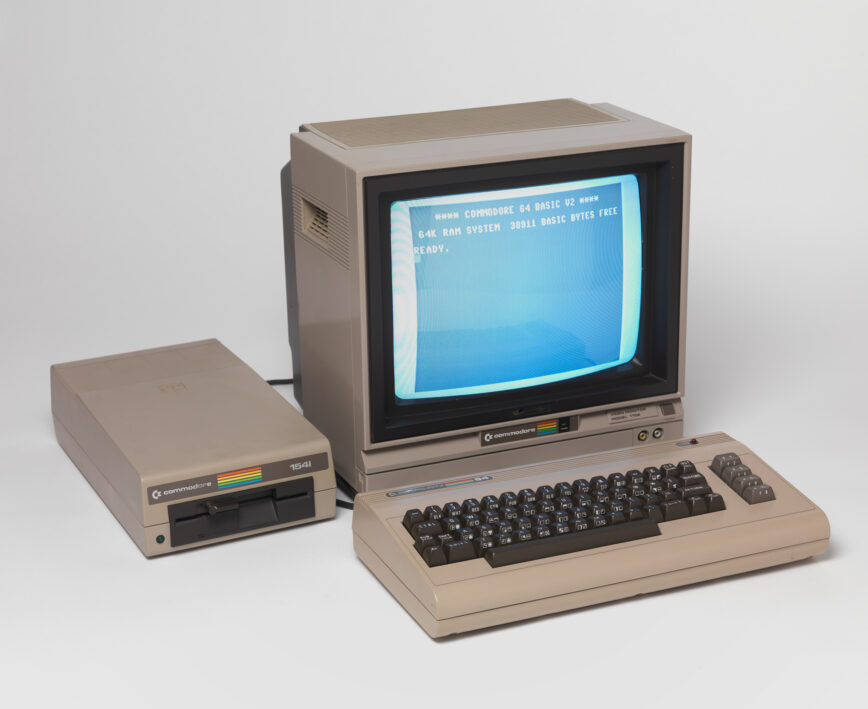
Commodore 64 – The Best-Selling PC of All Time (Image: interface-experience)
I started my personal computer journey with MS-DOS in the early to mid-90s and then Windows 98 which was my first serious experience with a graphical user interface. I remember spending hours customizing the desktop and exploring all the features and apps.
As my needs grew, I upgraded to Windows NT, which was released in July 1993. This was a business-oriented version of Windows with improved stability, security, and networking. I used Windows NT for several years, and it served me well for my work related tasks.
In 2001, Microsoft released Windows XP which quickly became the most popular version of Windows. It had improved performance, security, and multimedia and was suitable for both home and business use. I used Windows XP for several years and liked its stability and flexibility.
Microsoft released Windows 7 in 2009, which was a big improvement over Windows Vista. Windows 7 was faster and had an even more user-friendly interface. It became my go-to OS for both work and personal use. Like many of you, I spent many years on Windows 7.
During this time I was responsible for managing IIS 5 to 7 on Windows Server 2000 to 2008 which was a big responsibility. So back then while managing a few of my websites on IIS 7 I faced many performance and scaling issues.
Fortunately, I found alternative servers like, Lighttpd, and Nginx which run on Linux, especially on Debian and Ubuntu. This gave me higher throughput and better website performance.
Overall, Linux was more flexible, secure, performant and customizable and I used various Linux distributions for servers and desktops.
Back to Windows. But why?
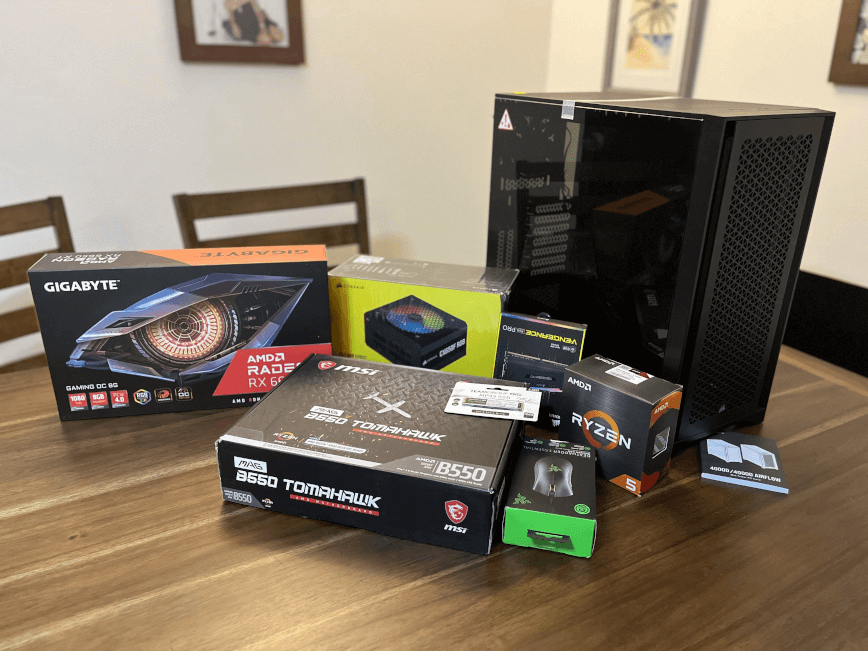
Parts/hardware for < $1000 PC build. Use this Part list and adjust it as needed.
Windows and Linux are two of the most popular operating systems used by individuals and businesses alike – Apple licenses macOS to their own hardware. Both have their strengths and weaknesses, and the choice of which one to use depends on the user’s needs and preferences. Before I switched I made sure I had a reliable backup of all my important data, so I wouldn’t lose anything during the transition. For my use case, here are the pros and cons of using Windows instead of Linux as my daily OS.
Pros of using Windows
- User-Friendly (or rather user-familiar): Windows has a familiar GUI.
- Gaming: Windows is the go-to OS for gamers, since most games are available for Windows.
- Hardware compatibility: Windows is compatible with almost all hardware and software.
- Microsoft Office: Microsoft Office Suite is a productivity tool used for business and personal use.
Cons of using Windows
- Cost: Windows is a commercial OS and it comes at a price.
- Security: Windows is more prone to malware and virus attacks than Linux.
- Bloatware: Windows comes with pre-installed apps that many users don’t need and can slow down the system.
- Privacy: Windows collects a lot of user data and there’s privacy concerns.
Pros of using Linux
- Free and Open-Source: Linux is free and open-source and can be downloaded, installed and used for free.
- Customizable: Linux is highly customizable and users can modify the source code if needed.
- Security: Linux is much less prone to malware and virus attacks than Windows.
- Speed: Linux is faster and more efficient than Windows.
Cons of using Linux
- Compatibility: Linux is not as compatible with all hardware and software available in the market.
- Steeper learning curve: Linux can be more challenging to use than Windows, especially for new users who are unfamiliar with the command line and the plethora of desktop environments and window managers available.
- Gaming: Gaming support for Linux is limited compared to Windows.
- Cloud syncing: Apart from Ubuntu, most Linux distros lack out-of-the-box cloud sync features to rival Apple’s iCloud, Microsoft’s OneDrive, or Google Drive.
Windows 10 is an operating system that most users are familiar with, and it has excellent hardware and software compatibility, making it a popular choice for many users. On the other hand, Linux is a free and open-source operating system with exceptional performance, privacy and security features, as well as insane levels of customizability.
As a long-time Linux user, I have been using various distributions over the past decade, including Arch, Ubuntu, Mint, Kali, Debian, Fedora, Manjaro, and more.
With these pros and cons in mind, I decided to switch back to Windows at the end of last year. Specifically, Windows 10. I was eager to explore the possibility of using Windows daily and try to take advantage of better hardware support for a new PC build that would double as a gaming PC; in hopes of reviving the gamer in me.
My PC build included an AMD Ryzen 5, 2024 update: AMD Ryzen 7, MSI MAG B550 TOMAHAWK motherboard, Gigabyte OC Radeon RX 6650 XT graphics card, and 16 GB of Corsair Vengeance DDR4-3600 CL16 memory. Switching to Windows 10 as my primary operating system was a significant change for me! Here’s what the build looks like currently:
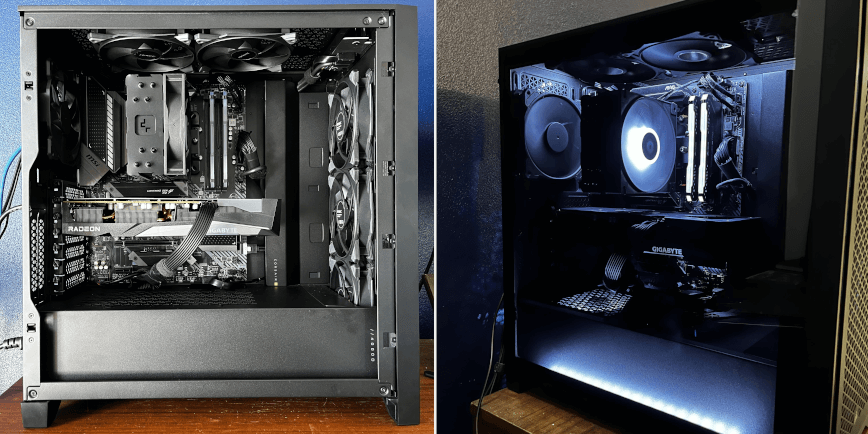
Most LEDs are either off or solid white. (View larger)
The reason I opted for Windows over Linux here was primarily because of the which allowed me to get the most out of the hardware. Or, at the very least, be able to set a baseline for later Linux tests.
I chose Windows over Linux here because of the better AMD driver support, which would allow me to get the most out of the hardware. Or at least set a baseline for later Linux tests.
Linux has come a long way, but Windows generally works better with AMD and Nvidia GPUs. This is expected since millions more end-users run AMD and Nvidia hardware on Windows, so in general it’s a more stable and performant experience.
Instead of going straight to a dual boot setup, I wanted to try using Windows on my desktop work PC and see how it would compare to Linux.
Windows as a Daily OS
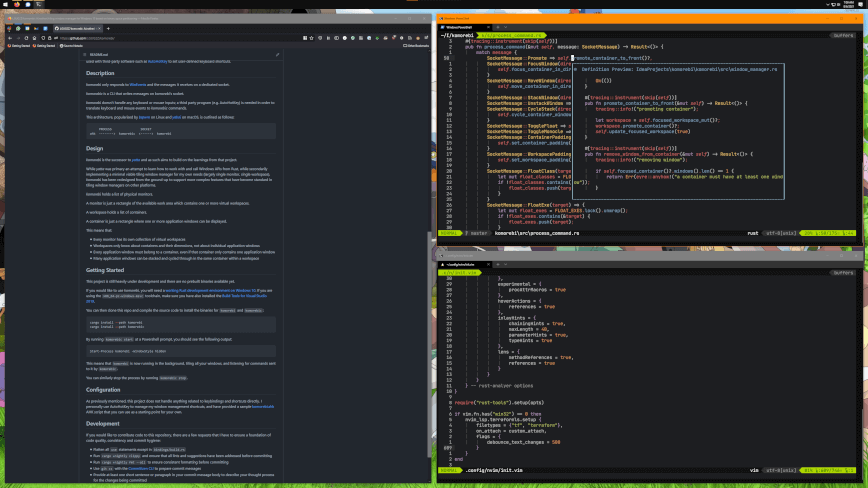
Komorebi tiling window manager on Windows 11. (Source: /r/UsabilityPorn)
I installed Windows 10 instead of 11 because I wanted the higher stability and lower frequency of Windows Updates.
When I switched to Windows 10, I was worried I wouldn’t be able to find suitable replacements for some of my favorite Linux apps. But I was pleasantly surprised to find many Windows apps that could replace my Linux apps.
For example, I used Termius to replace Remmina and WSL (Windows Subsystem for Linux) to have command-line Linux access. I installed Kali and WSLs to launch some GUI-only Linux apps natively, and I used AutoHotkey and Win3WM (but also komorebi tiling window manager) for Windows to keep my i3wm addiction at bay.
Issues I’m having with Windows 10
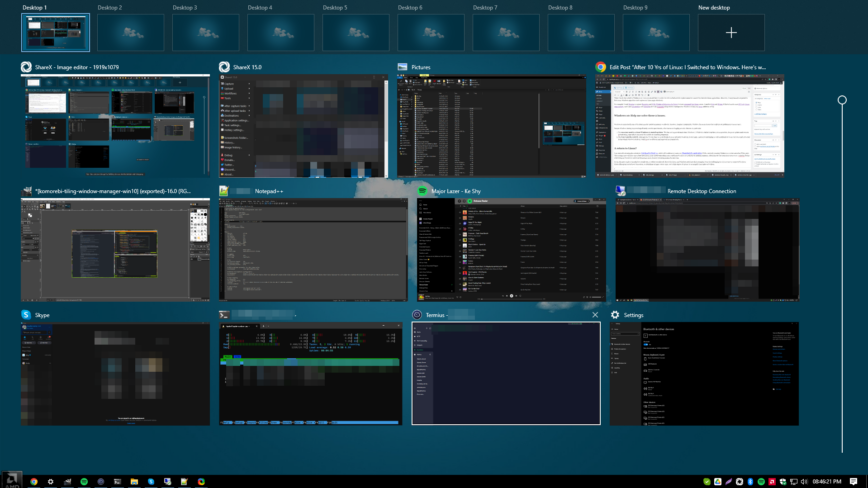
Default Windows 10 “task view” is cluttered and mouse-dependent.
Windows is one of the most used operating systems in the world. However, Windows has some issues that might be problematic to some users. So I’m excited to hear from others who have been using both Windows and Linux for years.
Windows has improved a lot over the past 10 years, but two issues still bug me:
- The constant need to reboot Windows to install updates. This has not improved much since Windows 7. While it is vital to keep the system up to date, frequent updates and restarts is frustrating, especially if you are in the middle of something important.
- The User Interface (UI) / workflow. Although the UI was closer to i3wm thanks to some 3rd party tweaking, it was buggy, making it challenging to work seamlessly at times. So I eventually reverted to the default Windows desktop, which was not as efficient and impacted my productivity.
Migrate back to Linux?
I am currently awaiting the arrival of a I’m now using a WD BLACK 1 TB SN770 (Kali Linux), and also replaced the TEAMGROUP 256 GB MP33 NVMe, which ran Windows 10, with an SK hynix Platinum P41 2 TB PCIe NVMe Gen4. Initially, I just purchased the cheapest storage I could find!
This setup allows me to boot into Linux as my default operating system and keep Windows 10 available for gaming purposes. Further strengthening a decision to switch back to Linux as my primary OS for daily use. I have been using Windows 10 with WSL as my daily workstation for the better part of 2024.
The past couple of months have taught me, or rather reconfirmed, that while Linux and Windows each have their strengths, it can be challenging for a Linux user to return to Windows. Linux offers great control over the system, an abundance of open-source apps, and a high degree of options to accomplish your tasks and wishes.
Should I stay with Windows?
I’m still writing this article on my Windows 10 work PC. So it’s not too late for me to find solution to the above issues. What do you think? Am I giving up too soon? Any tips to improve my Windows experience? How do you speed up your workflow and productivity on Windows?
Or, return to Linux?
While I wait for the NVMe boot drive to arrive, I’ve been trying to decide which flavor of Linux I should go with. Currently, I’ve narrowed the list down to: Kali-i3 (rolling-release no-pentest tools), Debian 12, Arch + xfce4 + i3 or Manjaro-i3. Any other suggestions? What are you guys running on your desktops and PC builds?
I will amended this article with my final decision. Follow updates here.
Published: January 12th 2024 | Updated: October 26th 2024





